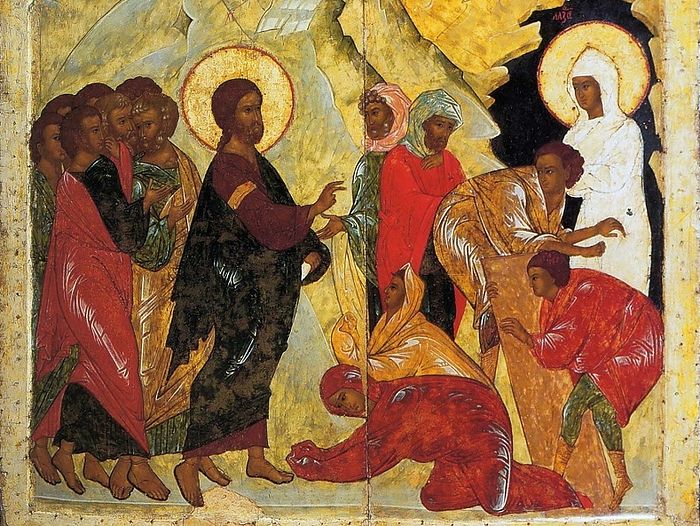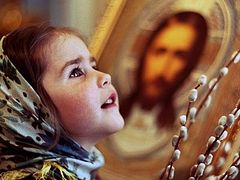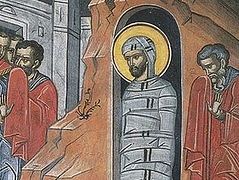Wishing to strengthen His disciples before His coming Passion on the Cross, the Lord works the greatest miracle that anyone has ever seen. Neither He nor the saints who lived before Him had ever raised decaying human corpses from the dead. The Raising of Lazarus is an image of both the Resurrection of Christ following it and the resurrection of all mankind that will come at the end of the world. St. John Chrysostom interprets the spiritual meaning of this wondrous miracle, which truly goes beyond the laws of nature and clearly shows the Savior’s divinity:
This was a luminous triumph leading up to the Resurrection of Christ. This was the glory of Lazarus unveiling the miracles of Christ. This image of Lazarus the Four Days Dead bears the fruit of Christ Who rose three days later. This Lazarus was a second forerunner to those who sat in darkness. This was the first enemy of hell’s defeat. Now Christ fills the entire world with His miracles. Now Christ defeats the power of death, raising Lazarus the Four Days Dead and giving us the image of His Resurrection (St. John Chrysostom. Homily 58).
“The loud voice of Christ raising Lazarus from the dead is a symbol of a great trumpet that will sound during the resurrection of all mankind” (Blessed Theophylact of Orchid).1
In his Explanation of the Holy Gospel According to St. John, Blessed Theophylact of Orchid condemns the Jewish rulers in bewilderment, because it was after this miracle—the raising of Lazarus—that they, blind with their hatred, finally plotted to put Christ to death. Moreover, Bl. Theophylact notes their malicious slyness. Trying to justify their cruelty, the Jewish priests spread a rumor about the supposed danger that because of the many miracles happening, the Romans suspect the whole Jewish nation of political instability. The the Jewish priests were determined to murder Lazarus as well. This would help them erase the memory of the miracle, which was a nuisance; moreover, this miracle had been worked on the eve of a great feast and served as an image of the ineffable glory of the Son of God whom they loathed. After Lazarus learned about it, he was forced to flee and conceal himself on Cyprus. The Synaxarion of Lenten Triodion says that ate only meals having some sweetness, because of the bitter taste in his mouth from having been dead. His bishop’s omophorion was a gift from the Theotokos: “Having sewn the omophorion, the Most Pure Mother of God gave it to him”.
Of the four evangelists, St. John the Theologian was the only one to tell us about the raising of Lazarus, who was still alive when three other apostles were recording their Gospels. St. John accurately revealed both the divine and the human natures of Christ—we see the Lord not only authoritatively breaking the laws of nature, but also shedding tears of sympathy and asking where they have laid Lazarus.
Unlike the other apostles, St. John promulgates a higher teaching and theologizes about what is great. For this reason, he speaks insignificantly of the Lord’s physical actions. For this reason, St. John find much that is human in the Lord and thus proves that His flesh was real, so that we would know that the Lord was both God and a man2.
The Holy Scripture, as we know, also bears a figurative meaning; therefore Blessed Theophylact offers us an additional explanation to the miracle that relates to us:
We must apply this miracle to the inner world. Christ’s friend is our mind, which is often overcome by its human nature; it falls into sins, and finally faces a most pathetic, spiritual death. However, it earns Christ’s sympathy, because the one who died was His friend. Let the sisters and relatives of the dead mind, like Martha (as Martha is more physical and material) and Maria (as Maria is more pious and reverent), come to Christ and fall down at His feet, bringing their confession, as Martha and Maria came with the Jews. For Judah means “confession of faith”. And the Lord will come without fail to the tomb and order that the blindness holding our mind captive be removed like the stone. He will call us to remember the future joy and suffering. The Lord will say with the loud voice of a trumpet: Come forth from the world and do not bury yourself in worldly amusements and passions. In doing this He will raise the dead from sin, though his wounds are evil-smelling. The dead man stank because had been in the tomb for four days, which means he was dead to the four meek and radiant virtues—he was idle and not moved to practise them. Though he could not move and his hands and feet were bound, though tightly squeezed by the knots of his own sins and seemingly unable to do anything, though his face was covered with cloth, so that with this fleshly covering he could not see anything divine, nevertheless he will hear: Ye good angels or priests who lead him to salvation, loose him and grant him forgiveness of his sins. May he go forth and do the works of love.3




